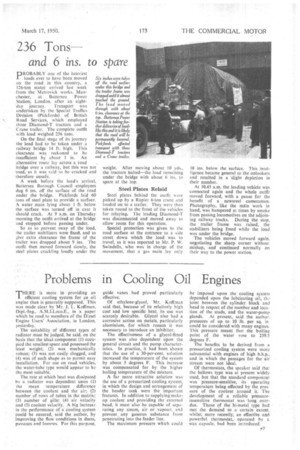Problems in Cooling Oil Engines
Page 41

If you've noticed an error in this article please click here to report it so we can fix it.
THERE is more in providing an efficient cooling system for an oil engine than is generally supposed: This was made clear by Mr. I. L. Koffman, Dipl.-Ing., A.M.I.Loco.E., in a paper which he read to illepthers of the Diesel Engine Users' Association, in London, yesterday.
The suitability of different types of radiator must be judged, he said, on the basis that the ideal component (1) occupied the smallest space and possessed the least weight; (2) was mechanically robust; (3) was not easily clogged, and (4) was of such shape as to permit easy installation. For use on road vehicles, the water-tube type would appear to be the most suitable.
The rate at which heat was dissipated by a radiator was dependent upon (1) the mean temperature difference between the coolant and the air; (2) number of rows of tubes in the matrix; (3) number of gills; (4) air velocity and (5) coolant velocity. A big increase in the performance of a cooling system could be ensured, said the author, by improving the flow conditions in ducts, passages and louvres: For this purpose,
guide vanes had proved .particularly effective.
Of ethylene-glycol, Mr. Koffman said that, because of its relatively high cost and low specific heat, its use was scarcely desirable. Glycol also had a corrosive action on metals, particularly aluminium, for which reason it was necessary to introduce an inhibitor, The effectiveness of a glycol-fitted system was also dependent upon the general circuit and the pump characteristics. In practice, it had been shown that the use of a 30-per-cent. solution increased the temperature of the system by about 5 degrees F. This increase was compensated for by. the higher boiling temperature of the mixture.
A far more attractive solution was the use of a pressurized cooling system, in which the design and arrangement of the. header tank were the important features. In addition to supplying makeup coolant and providing the external head; it most also be ieapabk of separating any steam, air or vapour, and prevent, any gaseous substance from penetrating into the feeder line.
The maximum pressure which could
he imposed upon the cooling system depended upon the lubricating oil, the joint between the cylinder block and head in respect of the number and location of the studs, and the water-pump glands. At present; said the author. pressures of up to 10 lb. per sq. in could be considered with many engines. This pressure meant that the boiling point of the water rose to 239.5 degrees F.
The benefits to be derived from a pressurized cooling system were more substantial with engines of high b.h.p., and in which the passages for the air stream were not ideal.
Of thermostats, the speaker said that the bellows type was at present widely used, but that the standard component was pressure-sensitive, its operating temperature being affected by the pressure of the coolant around it. The development of a reliable pressure. insensitive thermostat was long overdue. Those of the' bi-metal type had met the demand to a certain extent. whilst; more recently, an effectiVe 'and powerful thermostat, operated by wax capsule, had been introduced.




























































































